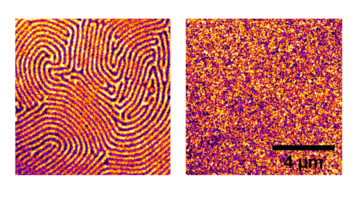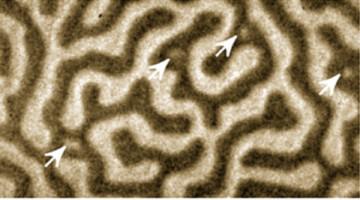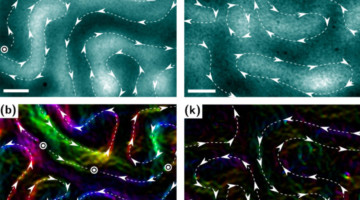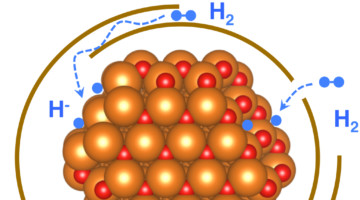Researchers combined soft x-ray spectroscopy and microscopy to demonstrate the tunable ferromagnetic characteristics of a two-dimensional layered material at room temperature. The results open up exciting opportunities for the use of such materials in low-power spintronics, high-density magnetic storage, and flexible electronics. Read more »
Ordered Magnetic Patterns in a Disordered Magnetic Material
Scientists have confirmed the presence of chirality, or handedness, in nanometers-thick samples of amorphous (noncrystalline) multilayer materials. The chirality—which potentially could be exploited to transmit and store data in a new way—was observed in the domain walls between neighboring regions of opposite spin. Read more »
Experimental Evidence of Chiral Ferrimagnetism in Amorphous GdCo Films
Harnessing high‐resolution Lorentz microscopy, Robert Streubel and co‐workers visualize chiral ferrimagnetic domain walls in amorphous films, revealing a composition dependence that potentially enables a temperature control of intrinsic domain wall properties. The reconstructed electron phase (magnetic induction) of achiral Bloch domain walls is shown here. Read more »
Reversible Fe(II) uptake/release by magnetite nanoparticles
The coexistence of magnetite and aqueous Fe2+ is common in anoxic subsurface environments and can have a great influence on important biogeochemical redox processes. This study demonstrates that the flow direction of electron equivalents in the form of Fe(II) across the magnetite–solution interface changes in a predictable fashion by altering solution pH, background Fe2+(aq) concentration, and magnetite loading. Read more »
Non-Crystal Clarity: Scientists Find Ordered Magnetic Patterns in Disordered Magnetic Material
Scientists have confirmed the presence chirality, or handedness, in nanometers-thick samples of amorphous (noncrystalline) multilayer materials. The chirality—which potentially could be exploited to transmit and store data in a new way—was observed in the domain walls between neighboring regions of opposite spin. Read more »
Toward Control of Spin States for Molecular Electronics
Researchers demonstrated, via x-ray absorption spectroscopy, that a molecule’s spin state can be reversibly switched at constant room temperature by magnetism. The results represent a major step toward the goal of programmable, nanoscale molecular electronics for high-speed, low-power, logic and memory applications. Read more »![]()
![]()
Ferromagnetism Emerges to Alleviate Polar Mismatch
A polar mismatch between nonferromagnetic materials drives an electronic reconstruction in which interfacial ferromagnetism is induced. The emergence of such functionality at interfaces could enable new types of electronics for a range of applications, including logic, memory, sensing, and more. Read more »![]()
A New Way to Tune Emergent Magnetism
Perpendicular magnetic anisotropy (PMA)—where magnetic moments in a thin film preferentially point out of the plane of the film—is an emergent phenomenon of both fundamental and technological interest. A combination of x-ray techniques demonstrate how to tune PMA in transition-metal oxide multilayers. Read more »![]()
![]()
Electrical Switching of Magnetic Vortex Circulation
Photoemission electron microscopy (PEEM) experiments have demonstrated that the circulation direction of a magnetic vortex can be switched by the application of an electric field, opening the door to digital devices with more streamlined system designs, improved performance, and greater energy efficiency. Read more »![]()
![]()
New Study on Graphene-Wrapped Nanocrystals Makes Inroads Toward Next-Gen Fuel Cells
A powdery mix of metal nanocrystals wrapped in single-layer sheets of carbon atoms shows promise for safely storing hydrogen for use with fuel cells for passenger vehicles and other uses. Now, a new study provides insight into the atomic details of the crystals’ ultrathin coating and how it serves as selective shielding while enhancing their performance in hydrogen storage. Read more »









